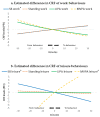The Relation between Domain-Specific Physical Behaviour and Cardiorespiratory Fitness: A Cross-Sectional Compositional Data Analysis on the Physical Activity Health Paradox Using Accelerometer-Assessed Data
- PMID: 33137943
- PMCID: PMC7662405
- DOI: 10.3390/ijerph17217929
The Relation between Domain-Specific Physical Behaviour and Cardiorespiratory Fitness: A Cross-Sectional Compositional Data Analysis on the Physical Activity Health Paradox Using Accelerometer-Assessed Data
Abstract
In contrast to leisure time physical activity (LTPA), occupational physical activity (OPA) does not have similar beneficial health effects. These differential health effects might be explained by dissimilar effects of LTPA and OPA on cardiorespiratory fitness (CRF). This study investigated cross-sectional associations between different physical behaviours during both work and leisure time and CRF by using a Compositional Data Analysis approach. Physical behaviours were assessed by two accelerometers among 309 workers with various manual jobs. During work time, more sedentary behaviour (SB) was associated with higher CRF when compared relatively to time spent on other work behaviours, while more SB during leisure time was associated with lower CRF when compared to other leisure time behaviours. Reallocating more time to moderate-to-vigorous physical activity (MVPA) from the other behaviours within leisure time was positively associated with CRF, which was not the case for MVPA during work. The results of our study are in line with the physical activity health paradox and we call for further study on the interaction between LTPA and OPA by implementing device-worn measures in a longitudinal design. Our results highlight the need for recommendations to take into account the different effects of OPA and LTPA on CRF.
Keywords: CVD risk; FEPA; aerobic workload; cardiorespiratory fitness; compositional data; leisure time physical activity; occupational health; occupational physical activity; physically demanding jobs.
Conflict of interest statement
The authors declare no conflict of interest. The funders had no role in the design of the study, in the collection, analyses, or interpretation of data; in the writing of the manuscript, or in the decision to publish the results.
Figures


Similar articles
-
Does Physically Demanding Work Hinder a Physically Active Lifestyle in Low Socioeconomic Workers? A Compositional Data Analysis Based on Accelerometer Data.Int J Environ Res Public Health. 2018 Jun 21;15(7):1306. doi: 10.3390/ijerph15071306. Int J Environ Res Public Health. 2018. PMID: 29933644 Free PMC article.
-
Assessing physiological response mechanisms and the role of psychosocial job resources in the physical activity health paradox: study protocol for the Flemish Employees' Physical Activity (FEPA) study.BMC Public Health. 2019 Jun 15;19(1):765. doi: 10.1186/s12889-019-6950-7. BMC Public Health. 2019. PMID: 31202266 Free PMC article.
-
The association between leisure-time physical activity and cardiorespiratory and muscular fitness and job strain-Study with a Northern Finland birth cohort of 1966.Stress Health. 2024 Oct;40(5):e3477. doi: 10.1002/smi.3477. Epub 2024 Sep 13. Stress Health. 2024. PMID: 39268984
-
The association between reallocations of time and health using compositional data analysis: a systematic scoping review with an interactive data exploration interface.Int J Behav Nutr Phys Act. 2023 Oct 19;20(1):127. doi: 10.1186/s12966-023-01526-x. Int J Behav Nutr Phys Act. 2023. PMID: 37858243 Free PMC article.
-
Associations of occupational and leisure-time physical activity with all-cause mortality: an individual participant data meta-analysis.Br J Sports Med. 2024 Dec 18;58(24):1527-1538. doi: 10.1136/bjsports-2024-108117. Br J Sports Med. 2024. PMID: 39255999 Free PMC article.
Cited by
-
Association of sitting time and cardiorespiratory fitness with cardiovascular disease risk and healthcare costs among office workers.Ind Health. 2023 Sep 22;61(5):368-378. doi: 10.2486/indhealth.2022-0010. Epub 2022 Oct 24. Ind Health. 2023. PMID: 36273913 Free PMC article.
-
Number of steps and systolic blood pressure: Do work and leisure matter?Scand J Med Sci Sports. 2021 Oct;31(10):1962-1970. doi: 10.1111/sms.14010. Epub 2021 Jul 9. Scand J Med Sci Sports. 2021. PMID: 34181778 Free PMC article.
-
Measurement of Sedentary Behavior-The Outcomes of the Angle for Posture Estimation (APE) Method.Sensors (Basel). 2024 Mar 31;24(7):2241. doi: 10.3390/s24072241. Sensors (Basel). 2024. PMID: 38610452 Free PMC article.
-
Associations of sleeping patterns and isotemporal substitution of other behavior with the prevalence of CKD in Chinese adults.Front Med. 2024 Apr;18(2):303-314. doi: 10.1007/s11684-023-1019-5. Epub 2023 Dec 5. Front Med. 2024. PMID: 38049616
-
Reallocation of time to moderate-to-vigorous physical activity and estimated changes in physical fitness among preschoolers: a compositional data analysis.BMC Public Health. 2024 Oct 14;24(1):2823. doi: 10.1186/s12889-024-20290-6. BMC Public Health. 2024. PMID: 39402478 Free PMC article.
References
-
- Vasankari V., Husu P., Vähä-Ypyä H., Suni J., Tokola K., Halonen J., Hartikainen J., Sievänen H., Vasankari T. Association of objectively measured sedentary behaviour and physical activity with cardiovascular disease risk. Eur. J. Prev. Cardiol. 2017;24:1311–1318. doi: 10.1177/2047487317711048. - DOI - PubMed
-
- Piepoli M.F., Hoes A.W., Agewall S., Albus C., Brotons C., Catapano A.L., Cooney M.-T., Corrà U., Cosyns B., Deaton C., et al. 2016 European Guidelines on cardiovascular disease prevention in clinical practice: The Sixth Joint Task Force of the European Society of Cardiology and Other Societies on Cardiovascular Disease Prevention in Clinical Practice (constituted by representatives of 10 societies and by invited experts) Developed with the special contribution of the European Association for Cardiovascular Prevention & Rehabilitation (EACPR) Eur. Heart J. 2016;37:2315–2381. doi: 10.1093/eurheartj/ehw106. - DOI - PMC - PubMed
-
- Department of Health and Social Care . Physical Activity Guidelines: UK Chief Medical Officers’ Report. Department of Health and Social Care; London, UK: 2019.
Publication types
MeSH terms
LinkOut - more resources
Full Text Sources
Medical
Miscellaneous

